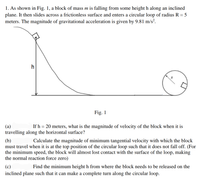
Elements Of Electromagnetics
7th Edition
ISBN: 9780190698614
Author: Sadiku, Matthew N. O.
Publisher: Oxford University Press
expand_more
expand_more
format_list_bulleted
Question
Kindly answer it as fast as you can.. and correctly.

Transcribed Image Text:1. As shown in Fig. 1, a block of mass m is falling from some height h along an inclined
plane. It then slides across a frictionless surface and enters a circular loop of radius R = 5
meters. The magnitude of gravitational acceleration is given by 9.81 m/s².
Fig. 1
(a)
If h = 20 meters, what is the magnitude of velocity of the block when it is
travelling along the horizontal surface?
(b)
must travel when it is at the top position of the circular loop such that it does not fall off. (For
the minimum speed, the block will almost lost contact with the surface of the loop, making
the normal reaction force zero)
Calculate the magnitude of minimum tangential velocity with which the block
(c)
inclined plane such that it can make a complete turn along the circular loop.
Find the minimum height h from where the block needs to be released on the
Expert Solution
This question has been solved!
Explore an expertly crafted, step-by-step solution for a thorough understanding of key concepts.
Step by stepSolved in 2 steps

Knowledge Booster
Learn more about
Need a deep-dive on the concept behind this application? Look no further. Learn more about this topic, mechanical-engineering and related others by exploring similar questions and additional content below.Similar questions
- 14. Determine the proper RPM for a 3" piece of cold-rolled steel with a cutting speed of SFPM. Round the nearest RPM. Hint: Refer to formulas and examples in your textb а. 102 b. 115 C. 87 d. 146 15. Calculate the machining time (in minutes, rounded to the nearest minute) for a part in length 10" diameter AISI/SAE 4140 steel using a cutting speed of 110 SFPM and a rate of 0.008 IPR. Hint: Refer to examples in your textbook. а. 47 b. 60 C. 86 d. 74arrow_forwardQ1. The lathe operates on the principle of.. a. the cutter revolving against the work piece. b. the cutting tool, that can be controlled, can be moved vertically across the work piece_ c. the work piece rotating against the cutting tool, which can be controlled. d. both cutter and work piece rotating.arrow_forwardConsider the gear train below where Gear D has 80 teeth and Gear A is spinning with 600 rpm. D 60 teeth the A 40 teeth 20 teeth a. What is the speed of Gear D? We want to adjust the gear train. We can only change out Gear C for a different sized gear. Gear A will continue spinning with 600 does our new Gear C need to have so that Gear D b. How many teeth rpm. spins with 200 rpm? B.arrow_forward
Recommended textbooks for you
 Elements Of ElectromagneticsMechanical EngineeringISBN:9780190698614Author:Sadiku, Matthew N. O.Publisher:Oxford University Press
Elements Of ElectromagneticsMechanical EngineeringISBN:9780190698614Author:Sadiku, Matthew N. O.Publisher:Oxford University Press Mechanics of Materials (10th Edition)Mechanical EngineeringISBN:9780134319650Author:Russell C. HibbelerPublisher:PEARSON
Mechanics of Materials (10th Edition)Mechanical EngineeringISBN:9780134319650Author:Russell C. HibbelerPublisher:PEARSON Thermodynamics: An Engineering ApproachMechanical EngineeringISBN:9781259822674Author:Yunus A. Cengel Dr., Michael A. BolesPublisher:McGraw-Hill Education
Thermodynamics: An Engineering ApproachMechanical EngineeringISBN:9781259822674Author:Yunus A. Cengel Dr., Michael A. BolesPublisher:McGraw-Hill Education Control Systems EngineeringMechanical EngineeringISBN:9781118170519Author:Norman S. NisePublisher:WILEY
Control Systems EngineeringMechanical EngineeringISBN:9781118170519Author:Norman S. NisePublisher:WILEY Mechanics of Materials (MindTap Course List)Mechanical EngineeringISBN:9781337093347Author:Barry J. Goodno, James M. GerePublisher:Cengage Learning
Mechanics of Materials (MindTap Course List)Mechanical EngineeringISBN:9781337093347Author:Barry J. Goodno, James M. GerePublisher:Cengage Learning Engineering Mechanics: StaticsMechanical EngineeringISBN:9781118807330Author:James L. Meriam, L. G. Kraige, J. N. BoltonPublisher:WILEY
Engineering Mechanics: StaticsMechanical EngineeringISBN:9781118807330Author:James L. Meriam, L. G. Kraige, J. N. BoltonPublisher:WILEY

Elements Of Electromagnetics
Mechanical Engineering
ISBN:9780190698614
Author:Sadiku, Matthew N. O.
Publisher:Oxford University Press

Mechanics of Materials (10th Edition)
Mechanical Engineering
ISBN:9780134319650
Author:Russell C. Hibbeler
Publisher:PEARSON

Thermodynamics: An Engineering Approach
Mechanical Engineering
ISBN:9781259822674
Author:Yunus A. Cengel Dr., Michael A. Boles
Publisher:McGraw-Hill Education

Control Systems Engineering
Mechanical Engineering
ISBN:9781118170519
Author:Norman S. Nise
Publisher:WILEY

Mechanics of Materials (MindTap Course List)
Mechanical Engineering
ISBN:9781337093347
Author:Barry J. Goodno, James M. Gere
Publisher:Cengage Learning

Engineering Mechanics: Statics
Mechanical Engineering
ISBN:9781118807330
Author:James L. Meriam, L. G. Kraige, J. N. Bolton
Publisher:WILEY